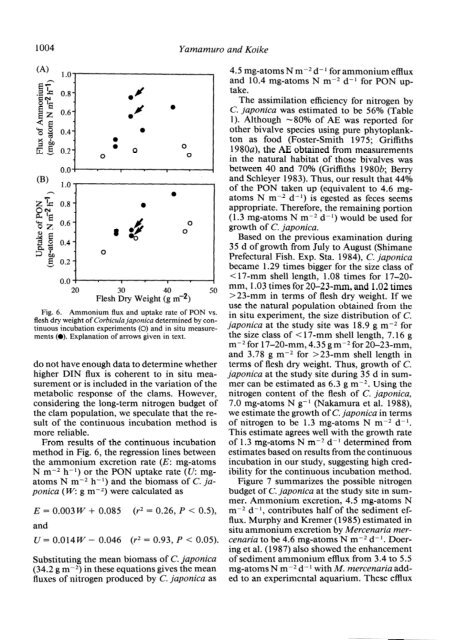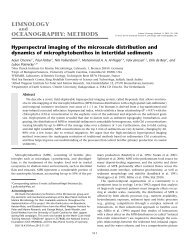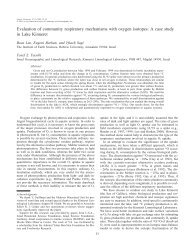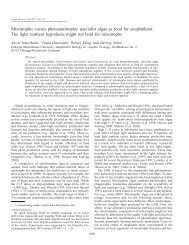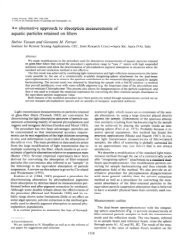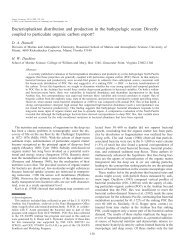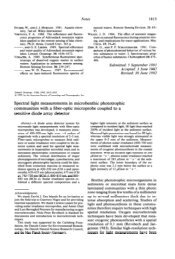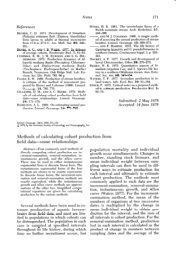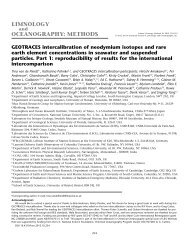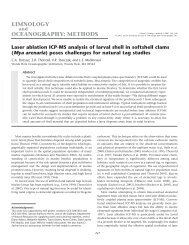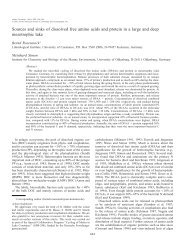Download - ASLO
Download - ASLO
Download - ASLO
Create successful ePaper yourself
Turn your PDF publications into a flip-book with our unique Google optimized e-Paper software.
1004 Yamamuro and Koike<br />
09<br />
0<br />
0<br />
0<br />
0.0 ! I I<br />
0<br />
0<br />
0<br />
0<br />
0<br />
0<br />
0<br />
0.0 I’ I I<br />
20<br />
Flesh gxy Weight $ rnw2)<br />
Fig. 6. Am lmonium flux and uptake rate of PON vs.<br />
flesh dry weight of Corbicula japonica determined by continuous<br />
incubation experiments (0) and in situ measurements<br />
(0). Explanation of arrows given in text.<br />
do not have enough data to determine whether<br />
higher DIN flux is coherent to in situ measurement<br />
or is included in the variation of the<br />
metabolic response of the clams. However,<br />
considering the long-term nitrogen budget of<br />
the clam population, we speculate that the result<br />
of the continuous incubation method is<br />
more reliable.<br />
From results of the continuous incubation<br />
method in Fig. 6, the regression lines between<br />
the ammonium excretion rate (E: mg-atoms<br />
N m--2 h-l) or the PON uptake rate ((1: mgatoms<br />
N m-2 h-l) and the biomass of C. japonica<br />
( W: g m-2) were calculated as<br />
E = 0.003W + 0.085 (r2 = 0.26, P < 0.5),<br />
and<br />
U = 0.014W - 0.046 (r2 = 0.93, P < 0.05).<br />
Substituting the mean biomass of C. japonica<br />
(34.2 g m-2) in these equations gives the mean<br />
a------ -.L-:* ____-- ---A ____ 1 t-. /-- .‘,,,..“.‘,, .-.,-.<br />
50<br />
4.5 mg-atoms N m-2 d-l for ammonium efflux<br />
and 10.4 mg-atoms N m-2 d-l for PON uptake.<br />
The assimilation efficiency for nitrogen by<br />
C. japonica was estimated to be 56% (Table<br />
1). Although -80% of AE was reported for<br />
other bivalve species using pure phytoplankton<br />
as food (Foster-Smith 1975; Griffiths<br />
1980a), the AE obtained from measurements<br />
in the natural habitat of those bivalves was<br />
between 40 and 70% (Griffiths 1980b; Berry<br />
and Schleyer 1983). Thus, our result that 44%<br />
of the PON taken up (equivalent to 4.6 mgatoms<br />
N m-2 d-l) is egested as feces seems<br />
appropriate. Therefore, the remaining portion<br />
(1.3 mg-atoms N m-2 d-l) would be used for<br />
growth of C. japonica.<br />
Based on the previous examination during<br />
35 d of growth from July to August (Shimane<br />
Prefectural Fish. Exp. Sta. 1984), C. japonica<br />
became 1.29 times bigger for the size class of<br />
< 17-mm shell length, 1.08 times for 17-20-<br />
mm, 1.03 times for 20-23-mm, and 1.02 times<br />
>23-mm in terms of flesh dry weight. If we<br />
use the natural population obtained from the<br />
in situ experiment, the size distribution of C.<br />
japonica at the study site was 18.9 g m-2 for<br />
the size class of < 17-mm shell length, 7.16 g<br />
m-2 for 17-20 -mm, 4.35 g m-2 for 20-23-mm,<br />
and 3.78 g m-2 for >23-mm shell length in<br />
terms of flesh dry weight. Thus, growth of C.<br />
japonica at the study site during 35 d in summer<br />
can be estimated as 6.3 g m-2. Using the<br />
nitrogen content of the flesh of C. japonica,<br />
7.0 mg-atoms N g-l (Nakamura et al. 1988),<br />
we estimate the growth of C. japonica in terms<br />
of nitrogen to be 1.3 mg-atoms N m-2 d-l.<br />
This estimate agrees well with the growth rate<br />
of 1.3 mg-atoms N m-2 d-l determined from<br />
estimates based on results from the continuous<br />
incubation in our study, suggesting high credibility<br />
for the continuous incubation method.<br />
Figure 7 summarizes the possible nitrogen<br />
budget of C. japonica at the study site in summer.<br />
Ammonium excretion, 4.5 mg-atoms N<br />
m-2 d- l, contributes half of the sediment ef-<br />
flux. Murphy and Kremer (1985) estimated in<br />
situ ammonium excretion by Mercenaria mercenaria<br />
to be 4.6 mg-atoms N m-2 d-l. Doering<br />
et al. (1987) also showed the enhancement<br />
of sediment ammonium efflux from 3.4 to 5 .S<br />
mg-atoms N rnA2 d- l with M. mercenaria added<br />
to an experimental aquarium. These efflux


